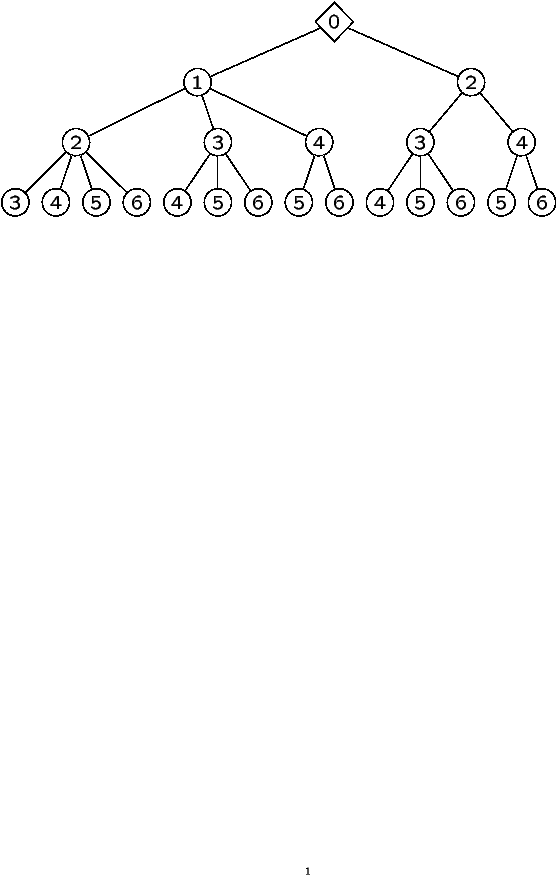 |
 |
Figure 3: The generating tree T for the (2,1)-case
and an isomorphic tree T~.
Our object is to explore the ``s-tennis ball problem'' (at each round s balls are available and we play with one ball at a time). This is a natural generalization of the case s=2 considered by Mallows and Shapiro. We show how this generalization is connected with s-ary trees and employ the notion of generating trees to obtain a solution expressed in terms of generating functions. Then, we present a variation in which at each round we have 4 balls and play with 2 balls at a time. To solve this problem we use the concepts of Riordan arrays and stretched Riordan arrays, and a generalization of generating trees. This is a joint work by D. Merlini with D. G. Rogers, R. Sprugnoli and M. C. Verri.
The configuration after 4 rounds is (1, 2, 3, 6) for the first example and (1, 2, 3, 4) for the second example. In fact, for the (2,1)-case, one has f1=2, f2=5, f3=14, f4=... do you guess what? There is indeed 42 different configurations (after 4 rounds), and if one adds all the sums, one gets S1=1+2=3, S2=(1+2)+(1+3)+(1+4)+(2+3)+(2+4)=23, S3=131, S4=664, ...
Turns Balls received Balls in the pocket Balls thrown away n=1 1 and 2 1 and 2 1 n=2 3 and 4 2, 3, and 4 3 n=3 5 and 6 2, 4, 5, and 6 2 n=4 7 and 8 4, 5, 6, 7, and 8 6 sum = 1+3+2+6= 12 Turns Balls received Balls in the pocket Balls thrown away n=1 1 and 2 1 and 2 2 n=2 3 and 4 1, 3, and 4 3 n=3 5 and 6 1, 4, 5, and 6 4 n=4 7 and 8 1, 5, 6, 7, and 8 1 sum = 2+3+4+1= 10
Figure 1: Two scenarios for the (s=2,t=1)-tennis ball player.
This is the only case solved with t¹ 1. The general (s,t)-tennis ball problem remains open.
Turns Balls received Balls in the pocket Balls thrown away n=1 1, 2, 3, 4 1, 2, 3, 4 2, 3, n=2 5, 6, 7, 8 1, 4, 5, 6, 7, 8 1, 7 n=3 9, 10, 11, 12 4, 5, 6, 8, 9, 10, 11, 12 10, 12 n=4 13, 14, 15, 16 4, 5, 6, 8, 9, 11, 13, 14, 15, 16 5, 16 2+3+1+7+10+12+5+16= 56
Figure 2: A scenario for the (4,2)-tennis ball problem.
More generally, the rewriting rule {
Figure 3: The generating tree T for the (2,1)-case and an isomorphic tree T~.
| root: (1) |
| rule: (k) |® (1)...(k+s-2)...(k+s-1) |
| Tn= |
|
and T(z)=1+zT(z)s . |
| Sn-1 = |
|
|
- |
|
|
|
|
. |
| Sn=An- |
|
Tn+1. |
| A(z)= |
|
+T'(z). |
| 2n |
| n |
| 2n+1 |
| n |
| Mm[n+1]= |
|
(m-r-1)Mr[n]. |
| n/k | 1 | 2 | 3 | 4 | 5 | 6 | 7 | 8 | 9 |
| 0 | 1 | ||||||||
| 1 | 3 | 2 | 1 | ||||||
| 2 | 22 | 16 | 10 | 4 | 1 | ||||
| 3 | 211 | 158 | 105 | 52 | 21 | 6 | 1 | ||
| 4 | 2306 | 1752 | 1198 | 644 | 301 | 116 | 36 | 8 | 1 |
| dn+1,k+1= |
|
aj dn,k+j for all n and k in N. |
| dn,k=[zn] g(z) | ( | zh(z) | ) | k where h(z)=A | ( | zh(z) | ) | . |
| n/k | 0 | 1 | 2 | 3 | 4 | 5 | 6 | 7 | |
| 0 | 1 | ||||||||
| 1 | 0 | 1 | |||||||
| 2 | 1 | 1 | 1 | ||||||
| 3 | 0 | 3 | 2 | 1 | |||||
| 4 | 6 | 6 | 6 | 3 | 1 | ||||
| 5 | 0 | 22 | 16 | 10 | 4 | 1 | |||
| 6 | 53 | 53 | 53 | 31 | 15 | 5 | 1 |
| 2n+4 |
| n+2 |
| n+3 |
| (n+3)/2 |
| Sn= |
|
|
µr[2n-2h] wr[2h]= |
|
|
µr[2n-2h]wr[2h]. |
| S(z)= |
|
|
( | µr(z)+µr(-z) | ) | ( | wr(z)+wr(-z) | ) | =12z2 +284z4+5436z6+96768z8+O(z10). |
http://www.dsi.unifi.it/~merlini/Publications.html.This document was translated from LATEX by HEVEA.